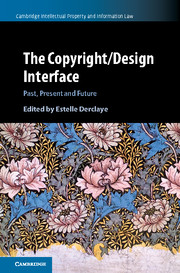13 results
4 - EU Design Law: Transitioning Towards Coherence? Fifteen Years of National Case Law
- from A - Forms and Institutions
-
-
- Book:
- Transition and Coherence in Intellectual Property Law
- Published online:
- 29 December 2020
- Print publication:
- 07 January 2021, pp 56-67
-
- Chapter
- Export citation
25 - Relationship between Trademark Law and Copyright/Design Law
- from IX - Overlapping Rights
-
-
- Book:
- The Cambridge Handbook of International and Comparative Trademark Law
- Published online:
- 18 September 2020
- Print publication:
- 24 September 2020, pp 421-435
-
- Chapter
- Export citation
Copyright page
-
- Book:
- The Copyright/Design Interface
- Published online:
- 23 February 2018
- Print publication:
- 08 March 2018, pp iv-iv
-
- Chapter
- Export citation
Introduction
-
-
- Book:
- The Copyright/Design Interface
- Published online:
- 23 February 2018
- Print publication:
- 08 March 2018, pp 1-6
-
- Chapter
- Export citation
8 - The Copyright/Design Interface in Italy
-
-
- Book:
- The Copyright/Design Interface
- Published online:
- 23 February 2018
- Print publication:
- 08 March 2018, pp 269-296
-
- Chapter
- Export citation
Dedication
-
- Book:
- The Copyright/Design Interface
- Published online:
- 23 February 2018
- Print publication:
- 08 March 2018, pp v-vi
-
- Chapter
- Export citation
12 - A Model Copyright/Design Interface: Not an Impossible and Undesirable Task?
-
-
- Book:
- The Copyright/Design Interface
- Published online:
- 23 February 2018
- Print publication:
- 08 March 2018, pp 421-458
-
- Chapter
- Export citation
Contributors
-
- Book:
- The Copyright/Design Interface
- Published online:
- 23 February 2018
- Print publication:
- 08 March 2018, pp xii-xiv
-
- Chapter
- Export citation
Preface
-
- Book:
- The Copyright/Design Interface
- Published online:
- 23 February 2018
- Print publication:
- 08 March 2018, pp xv-xvi
-
- Chapter
- Export citation
Figures
-
- Book:
- The Copyright/Design Interface
- Published online:
- 23 February 2018
- Print publication:
- 08 March 2018, pp ix-xi
-
- Chapter
- Export citation
Contents
-
- Book:
- The Copyright/Design Interface
- Published online:
- 23 February 2018
- Print publication:
- 08 March 2018, pp vii-viii
-
- Chapter
- Export citation
Index
-
- Book:
- The Copyright/Design Interface
- Published online:
- 23 February 2018
- Print publication:
- 08 March 2018, pp 459-472
-
- Chapter
- Export citation

The Copyright/Design Interface
- Past, Present and Future
-
- Published online:
- 23 February 2018
- Print publication:
- 08 March 2018



